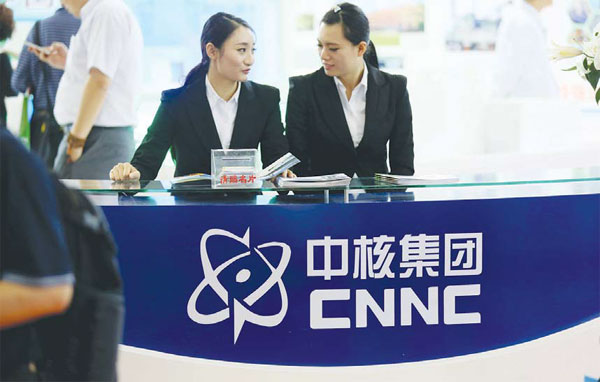Deal to advance launch of nuclear icebreakers
Updated: 2016-07-28 07:01
By Zhong Nan(China Daily)
|
|||||||||
 |
|
CNNC's booth at an expo. [Photo Provided to China Daily] |
Country's conventional capacity still insufficient in polar areas in extreme weather, experts say
The cooperation deal signed between China National Nuclear Corp and China State Shipbuilding Corp will add new momentum to developing the country's civil maritime nuclear power technologies, experts said on Wednesday.
Even though they didn't disclose the details of the agreement, the deal will push CNNC and CSSC to accelerate the pace of developing nuclear-powered icebreakers and maritime nuclear power platforms, according to a China Business News report on Tuesday.
The two State-owned companies signed a strategic cooperation framework agreement last week to enhance the integration of the civil and military industries and the Belt and Road Initiative.
Zhang Luqing, a nuclear expert at CNNC's science and technology commission, said their specialist structures building nuclear icebreakers were totally different to the techniques involved in constructing nuclear-powered submarines and aircraft carriers.
"China currently only has one diesel-powered icebreaker-the Ukraine-built Xuelong, or Snow Dragon-but its ice-breaking capacity is still insufficient in certain polar areas under extreme weather conditions," said Zhang.
"The country therefore needs advanced vessels to carry out scientific research in both the Arctic and Antarctic waters."
Eager to enhance its innovation abilities, CNNC announced in 2014 it would work with related parties and deploy more resources to develop nuclear-powered icebreakers.
Although countries including Russia, Ukraine, Canada and the Netherlands are major builders of icebreakers, only Russia is capable of producing nuclear-powered icebreakers, with a fleet size between nine and 10.
An icebreaker must be equipped with a strengthened hull, an ice-clearing shape, and sufficient power to push through sea ice, which normal vessels don't possess.
"For a nuclear-powered icebreaker, 10 kilograms of nuclear fuel is equal to burning 25,000 metric tons of standard coal," said Dong Liwan, a shipping industry professor at Shanghai Maritime University.
"Producing nuclear-powered icebreakers will not only test a shipyard's ability to manufacture such a high-end ship, but also provide a test for nuclear technology companies to install all the equipment for the ship's power system," said Dong.
Hu Keyi, technical director of Jiangnan Shipyard (Group) Co Ltd, a Shanghai-based CSSC subsidiary, said competitive bids for the construction of China's second polar research ship were expected this year and the new vessel would boast stronger ice-breaking capabilities.
The ship's estimated cost is more than 1 billion yuan ($149.93 million) and the construction is expected to take about 24 months.
"China has excess capacity in building conventional ships, but not in complex and high value-added ships," said Hu.
Related Stories
'Act now' to recruit for nuclear industry, says expert 2016-07-27 02:19
Nuclear power important in China's future energy mix: report 2016-07-16 15:25
Work to start on 3rd unit of Karachi K3 nuclear plant in Pakistan 2016-05-31 07:47
First nuclear plant to take to the seas 2016-07-26 07:04
China National Nuclear to build nuclear reactor in Sudan 2016-05-25 02:46
Today's Top News
No explosion, no injury report in Germany: Police
Geneva airport tightens security after French tipoff
Bill Clinton portrays Hillary as 'change-maker'
Priest, 84, killed in France, attack claimed by IS
Knife attacker in Japan kills 19 at disabled center
Michelle Obama rocks Democratic convention
Syrian suicide bomber in Germany faces deportation
Shooting at Florida nightclub kills, wounds 16
Hot Topics
Lunar probe , China growth forecasts, Emission rules get tougher, China seen through 'colored lens', International board,
Editor's Picks

|

|

|

|

|

|







